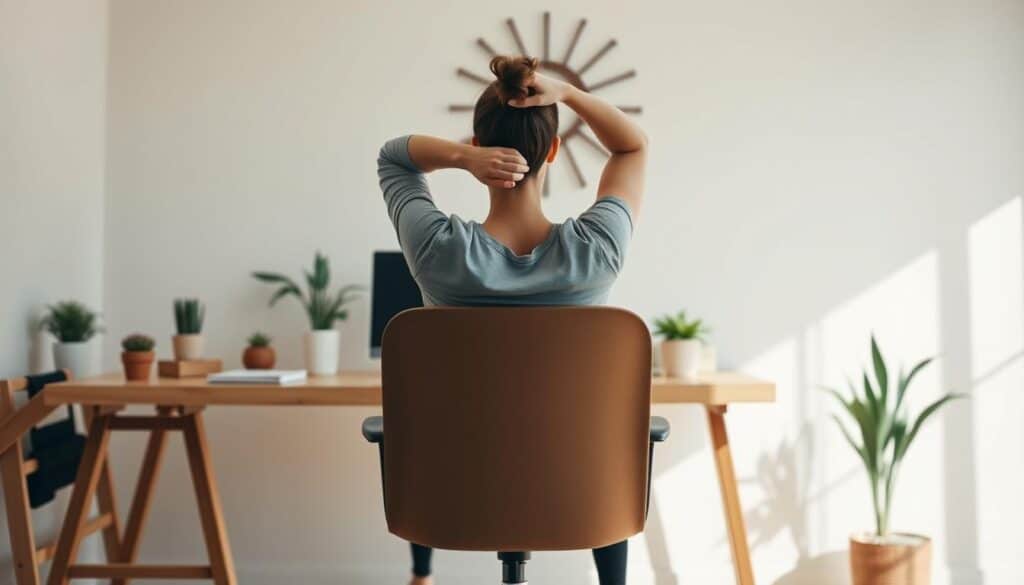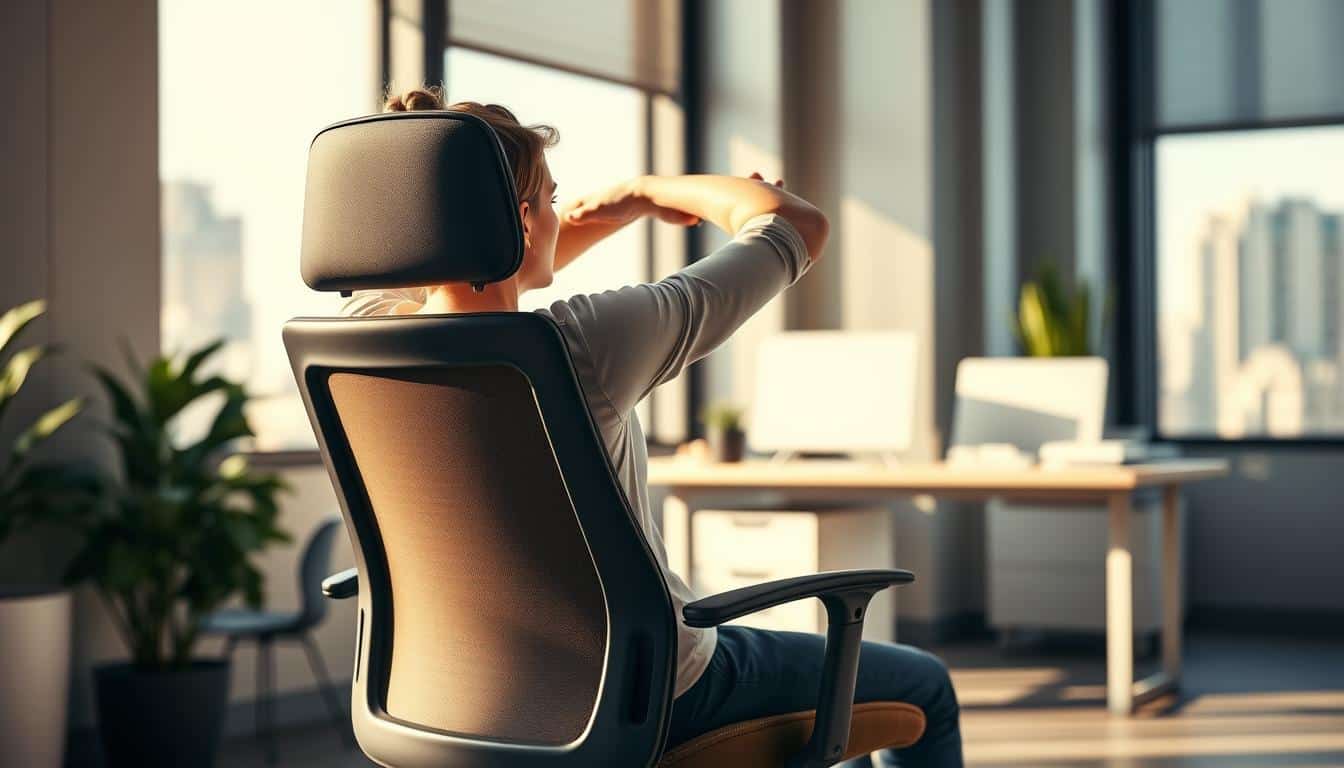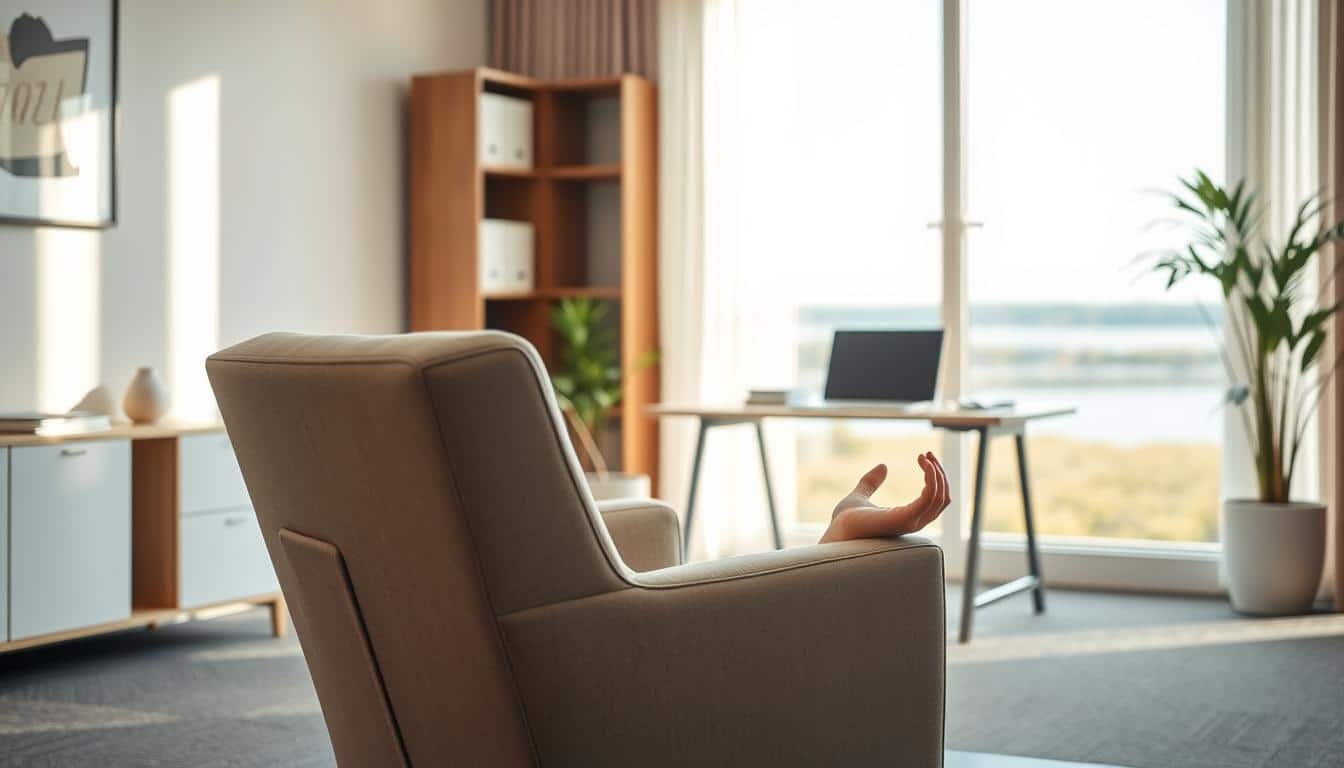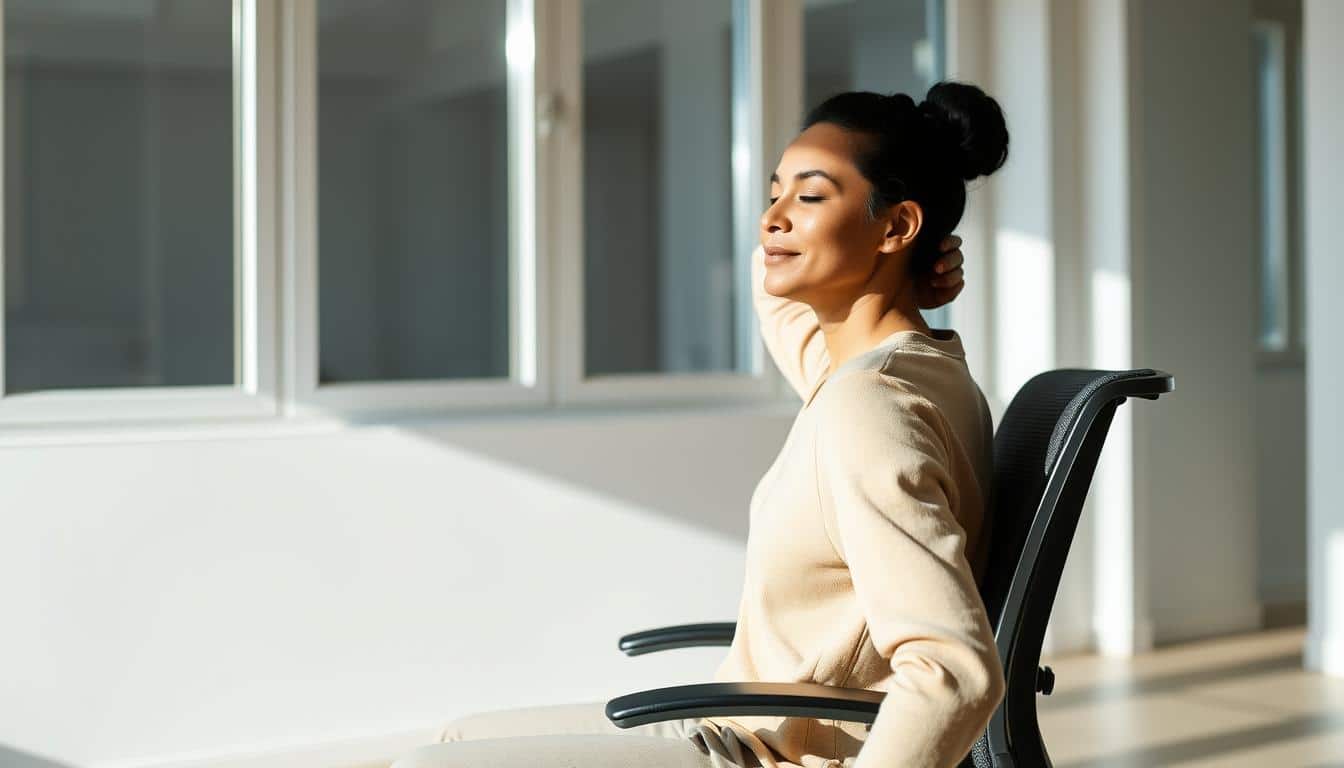In today’s busy world, adding simple chair stretches to your day can boost your wellness. These stretches are easy and help increase flexibility and comfort. They are good for anyone, no matter your physical ability. With many people sitting a lot at work, it’s important to fight the bad effects on our body and mind.
Chair stretches help you move more without needing lots of time or special gear. Doing these stretches often can improve your sitting posture, lessen stress, and help blood flow better. By making sure to move around during your day, you can feel better physically and mentally. This leads to a healthier place to work. Choosing the right chair is key for these stretches; use a stable chair for safety and the best results. Adding these stretches to your day can make it more fun and productive.
The Importance of Movement in Daily Life
Moving every day is key to staying healthy. Sitting too much can lead to health problems. It’s important to keep active to avoid weak muscles and poor blood flow. These can lead to serious issues like heart disease and obesity.
Consequences of Prolonged Sitting
Studies show that sitting a lot can hurt office workers. Sitting too long can:
- Make muscles and joints weak and stiff.
- Slow down blood flow and stop nutrients from reaching important parts of the body.
- Boost the chance of getting lifelong health problems. This affects both body and mind.
Benefits of Regular Movement
Regular exercise has many benefits. It fights the problems of sitting too much. These benefits include:
- Better movement and flexibility for everyday tasks.
- Faster blood flow which helps muscles recover and lessens pain.
- More serotonin to lower stress and improve mood.
- Less muscle stiffness, leading to better posture.
- Fewer injuries, making physical activities safer.
Adding simple exercises to your day can make a big difference. This is true even with a busy schedule. Make moving a daily priority to improve your life.
What Are Chair Stretches?
Chair stretches are exercises you do while sitting down. They make you move without working as hard as in regular stretches. They ease muscle tightness and help you sit better, which is great if you sit a lot. These stretches focus on different body parts, bringing many health gains.
Definition and Benefits
Chair stretches mean doing exercises seated, keeping you stable and safe. They offer lots of health benefits, such as:
- Relieving tension accumulated from long periods of sitting.
- Improving circulation to prevent stiffness.
- Enhancing flexibility, which is crucial for maintaining mobility.
Who Can Benefit from Chair Stretches?
Lots of people can do chair stretches, especially:
- Seniors who may require gentler forms of exercise.
- Individuals recovering from injuries, who need low-impact options.
- Anyone engaged in desk work who experiences discomfort from sitting.
Adding these chair stretches to your day can reduce pain and improve your posture. There are different types like the Side Neck Stretch, the Turtle, Hip Opener, Forward Bend, and Simple Twist. Each one helps with the soreness from sitting too long.
How Chair Stretches Improve Flexibility
Chair stretches play a big role in increasing flexibility and mobility. These are key for a well-functioning lifestyle. Doing these stretches often brings many benefits. It helps ease muscle tightness caused by sitting too long.
Flexibility and Mobility in Everyday Activities
Stretches done while seated make you more flexible. They loosen tight muscles and help blood flow better. This is good for people who don’t move around much.
Trying out specific stretches like the neck and chest stretch, seated cat-cow, and seated hamstring stretch is useful. These target stiff areas. With a better range of motion, doing daily activities becomes easier.
Reducing Muscle Tightness with Stretches
Chair exercises are great for more than flexibility. They also help with muscle tightness that can make you uncomfortable. Stretching parts like your neck, hamstrings, and ankles focuses on different muscles. This increases flexibility.
Doing these stretches the right way prevents injuries and gives the best results. They can also lessen pain by reducing muscle stress and joint pressure. This means you feel better overall.
Incorporating Chair Stretches into Your Workday
Adding chair stretches into your daily work can really make you feel better. It’s key to stretch regularly for good physical and mental health. Try to take short breaks every 45 minutes for stretching. This will help keep you from getting stiff and make you more productive.
Setting a Routine for Regular Stretches
Commitment and planning are needed to make chair stretches a part of your day. To blend these stretches seamlessly into your schedule, follow these steps:
- Use reminders or apps to tell you when it’s time to stretch a bit.
- Plan your stretch breaks with coffee or lunch times.
- Aim to have three to four stretch breaks during your day.
Utilizing Breaks for Quick Stretch Sessions
Use your break time to refresh both body and mind. Desk stretches are quick and doable, even on busy days. Try these easy stretches next time you take a break:
- Seated forward flexion stretch – bend forward with straight legs; hold for 30 seconds.
- Seated figure four stretch – cross one leg over the other; lean forward to feel a stretch for 30 seconds.
- Seated marches – lift each leg alternately while keeping your back straight.
Regular chair stretches improve your posture and ease muscle tension all day. Making this a habit can give you energy and focus at work.
Top Chair Stretch Routines for the Office
Stretching at your desk can ease the strain of sitting too long. These stretches don’t require you to leave your chair and help loosen up tense areas. Let’s look at some easy routines to keep you flexible and comfortable all day.
Neck and Shoulder Stretches
Neck and shoulder stretches can cut down on the stiffness from sitting hours on end. Try these easy moves to ease muscle tightness:
- Ear-to-Shoulder Stretch: Sit up straight and lower one ear to your shoulder, holding for 15 seconds. Do it on the other side 2-3 times.
- Chin-to-Chest Stretch: Use your hands to gently pull your head down towards your chest. Hold it there for 15 seconds and do it 2-3 more times.
- One Arm Hug: Cross one arm across your chest and hold the opposite shoulder. Push gently on the elbow for 30 seconds and switch arms, doing 2-3 repetitions each.
Lower Back and Hip Stretches
To keep your lower back and hips flexible, try these stretches. They’ll help relieve tension in these crucial areas:
- Seated Spine Twist: Cross one leg over the other and twist toward your top leg, holding onto the chair for a deeper stretch. Hold for 30 seconds and do it three times on each side.
- Hamstring Chair Stretch: Sit and straighten your legs, then bend forward at the waist, keeping your back straight. Hold this for 30 seconds and repeat 3-5 times.
- Office Chair Back Stretch: Sit up, reach behind your chair, arch your back and push your chest out for 30 seconds. Do this five times.
Full-Body Stretches from a Seated Position
For overall flexibility and to prevent stiffness, full-body stretches are great. Here are some you can do right from your seat:
- Reach for the Sky: Lace your fingers together above your head, palms up. Sit up tall and push your hands up to stretch your spine. Hold for 10 seconds and repeat five times.
- Chest Opener Stretch: Move to the front of your chair and hold its back with both hands. Lean forward for 10 seconds. Do this stretch three times.
- Wrist Stretch: Put your palms together in front of your chest for 15 seconds, then press the backs of your hands together for another 15 seconds. Repeat five times.
Mindfulness During Chair Stretches
Adding mindfulness to chair stretches improves your experience, helping you feel better physically and emotionally. When you focus mindfully during these stretches, your mind and body work together. This enhances your awareness of your body. Deep, focused breathing while stretching helps relax you and lower stress.
The Connection Between Mind and Body
Starting a body check-in means scanning from your feet up to your head. It lets you notice how you’re feeling physically at the moment. By adding gentle neck stretches, you boost this sensation. This helps you move easily and safely.
Making deliberate moves changes your body’s shape and how you feel. Different poses can make you experience things in new ways. They can help wake up your curiosity and make mindfulness and moving your body more connected.
Breathing Techniques to Enhance Stretching
Doing deep breaths while sitting, especially using the diaphragm, can make you more relaxed and increase oxygen. Trying out fun moves like Blossoming Flower Arms brings energy to your arms and fingers. With Full Arm Circles, you can explore how your body feels moving in different ways.
Moving Forward Folds help you stretch and strengthen. They let you find out which parts of your body are working when you move. These breathing and moving exercises get you ready for more mindfulness activities. They make your overall experience richer.
Chair Stretch for Seniors and Those with Limited Mobility
Chair stretches are vital for seniors and those who can’t move around much. They help in maintaining health through easy exercises. These stretches fit different levels of fitness and focus on being safe and comfortable. Here, we list some simple stretches that everyone can try.
Gentle Stretches for All Levels
Chair stretches help improve blood flow and make you more flexible. This includes easy exercises like:
- Wrist and Ankle Rolls: These get your blood moving and your joints looser by moving your hands and feet in circles.
- Knee Marches: Raising your knees helps with hip movement and keeps your heart healthy.
- Seated Rows: This makes the muscles in your upper back and chest stronger, which helps you stand straighter.
- Arm Raises: Lifting your arms builds strength in your shoulders and arms. Add resistance to challenge yourself.
- Seated Torso Twist: Turning your upper body strengthens your middle section and helps with balance.
- Inner Thigh and Hand Squeeze: Pressing a soft ball with your knees or hands builds strength in your upper body and thighs.
- Calf Raises: Raising your heels works on your leg strength and blood flow.
- Heel Slides: Sliding your heels forward and back while sitting targets your hamstrings and core.
It only takes four minutes to do this routine, so it’s easy to fit into your schedule. Move gently, only as much as feels okay, and avoid any moves that hurt.
Adapting Stretches for Safety and Comfort
It’s important to make changes to these exercises for those with less mobility. This can mean:
- Changing how far you move to stay comfortable.
- Using things like pillows for better support during exercises.
- Taking the stretches slowly to stay aware of how they feel.
Stretching while seated is great because it’s safe and lowers the chance of falling. Doing these gentle exercises regularly helps you stay active without getting hurt.
Benefits of Chair Stretch in Reducing Workplace Stress
Many American workers sit at desks all day. This can lead to health problems due to not moving much. Chair stretches can help reduce stress at work. They ease physical and mental tiredness. Doing stretches often makes the workplace healthier and boosts work performance.
Combatting Physical Discomfort from Desk Work
Working at a desk can cause bad posture and strain. This might lead to neck and back pain, or even carpal tunnel syndrome. Chair stretches can help by:
- Alleviating muscle tension and pain.
- Improving posture, which reduces the risk of chronic pain.
- Enhancing flexibility and strength, essential for daily activities.
- Increasing blood flow and circulation, boosting energy levels.
Studies show that stretching at work could reduce pain by up to 72 percent. Moving around not only lessens physical pain but also improves overall health.
Enhancing Mental Clarity and Focus
Doing chair stretches during work improves mental focus. Focusing on breathing and being aware of your body during stretching leads to:
- Reduced stress and anxiety through intentional movement.
- Heightened focus and an increase in productivity.
- Promotion of mindfulness, which encourages individuals to stay engaged and present.
- Creative boosts as mental stress and tension are alleviated.
Taking brief stretching breaks is good for both mental and physical health. It helps create a positive workplace. It also helps prevent burnout.
Consistency is Key: Building a Stretching Habit
Having a regular stretching routine can really help your health. Adding stretching to your daily habits improves flexibility and makes sitting all day less painful. To keep up with stretching, set weekly goals that are simple and you can reach.
Creating Weekly Stretching Goals
It helps when your goals are clear, measurable, and possible to achieve. Here’s how to set good weekly goals:
- Plan to stretch 2-3 times each week.
- Choose certain stretches, like seated twists or side stretches, to do more often.
- Keep track of your progress to see how you’re getting more flexible over time.
Utilizing Reminders and Apps to Stay on Track
Reminders keep you focused on stretching regularly. Use calendar alerts or apps that encourage you to move around. Here are some tips:
- Set reminders to stand up and stretch every half-hour to an hour.
- Track your stretching in fitness apps to see your daily achievements.
- Join online groups for extra support and encouragement to keep going.

With these habits and helpful reminders, stretching can offer many benefits. It boosts your flexibility and overall health, and makes daily tasks more comfortable.
Conclusion
Doing chair stretches regularly brings lots of health benefits. It greatly improves your life quality. Targeted stretching helps reduce the discomfort from sitting too long.
These stretches, like side reaches and hip rotations, increase your flexibility. They also reduce stress and tension after a long day of work.
A 2023 study in Healthcare showed chair yoga’s positive effects on older adults. These benefits are not just physical. They also boost mental health and balance. People of all ages, including office workers and seniors, can feel more energetic by doing these stretches daily.
In short, making chair stretches a daily habit tackles physical discomfort. It also makes you more productive and mentally sharp. For the best benefits, practice every day. Make sure to adjust the stretches to stay comfortable and maintain good posture. Small movements can lead to a healthier, more flexible you.



